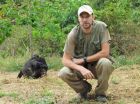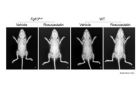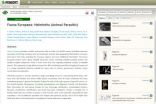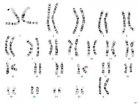(Press-News.org) In the 1970s, Jane Goodall's reports of chimpanzee violence caught the attention of a global audience. Since then, many people have compared chimpanzee intergroup aggression to primitive warfare and have argued that chimpanzee violence is an adaptive strategy that gives the perpetrators an edge. Others have argued that lethal aggression is the consequence of human activities such as provisioning (artificial feeding) by researchers or habitat destruction. A new study of the pattern of intergroup aggression in chimpanzees and their close relatives, bonobos (also called pygmy chimpanzees), finds that human impact isn't the culprit.
"This study debunks the idea that lethal aggression among wild chimpanzees is an aberrant behavior caused by human disturbances, like artificial feeding or habitat loss," says ASU anthropologist Ian Gilby. Gilby is codirector of the long-term Gombe chimpanzee database for the Jane Goodall Institute Research Center and a coauthor on the results published in the journal Nature on September 18.
The research project compiled data collected over five decades from 18 chimpanzee (Pan troglodytes) and four bonobo (Pan paniscus) communities.
This study represents the first effort to test the human impact versus adaptive strategies hypothesis, which views killing as an evolved tactic to increase access to territory, food, mates or other benefits. Analysis of 152 lethal attacks finds that it is clear that lethal aggression directed toward members of other groups is part of the natural behavioral repertoire of chimpanzees—sometimes chimpanzees kill each other, regardless of human impact. However, bonobos were not observed to kill other bonobos, whatever the level of human impact.
"Gombe is longest running of wild chimpanzee study sites," says Gilby, "and is critically important for addressing questions about the impact of 'provisioning.'" The practice of provisioning was discontinued at Gombe many years ago due to risk of infecting chimpanzees with human diseases.
Concurrent with the published study in Nature, Joan Silk, an ASU scientist who studies primate behavioral ecology, evolution and sociality, wrote a companion piece, "The evolutionary roots of lethal conflict" for the publication's "News and Views" column. In it, Silk points out that the debates about the origins and prevalence of human warfare may be echoed in the search for the answer to chimpanzee adaptation versus human disturbance question. In the article, she says that "perceptions of behavior of primates, particularly chimpanzees, are often distorted" so that "morally desirable features, such as empathy and altruism, have deep evolutionary roots, whereas undesirable features, such as group-level violence and sexual coercion, do not."
The data, however, she says, show that "there are some circumstances in which the benefits of lethal aggression exceed the costs for chimpanzees, nothing more. Humans are not destined to be warlike because chimpanzees sometimes kill their neighbors."
INFORMATION:
Gilby, an assistant professor in ASU's School of Human Evolution and Social Change, studies chimpanzee behavioral ecology at Gombe, focusing on male cooperation and social bonds. Silk is a professor in the School of Human Evolution and Social Change. Both Gilby and Silk are research affiliates with ASU's Institute of Human Origins.
Chimpanzee lethal aggression a result of adaptation rather than human impacts
2014-09-17
ELSE PRESS RELEASES FROM THIS DATE:
Researchers use iPS cells to show statin effects on diseased bone
2014-09-17
Skeletal dysplasia is a group of rare diseases that afflict skeletal growth through abnormalities in bone and cartilage. Its onset hits at the fetal stage and is caused by genetic mutations. A mutation in the gene encoding fibroblast growth factor receptor 3 (FGFR3) has been associated with two types of skeletal dysplasia, thanatophoric dysplasia (TD), a skeletal dysplasia that cause serious respiratory problems at birth and is often lethal, and achondroplasia (ACH), which causes stunted growth and other complications throughout life. Several experimental treatments have ...
Math model designed to replace invasive kidney biopsy for lupus patients
2014-09-17
COLUMBUS, Ohio – Mathematics might be able to reduce the need for invasive biopsies in patients suffering kidney damage related to the autoimmune disease lupus.
In a new study, researchers developed a math model that can predict the progression from nephritis – kidney inflammation – to interstitial fibrosis, scarring in the kidney that current treatments cannot reverse. A kidney biopsy is the only existing way to reach a definitive diagnosis of the damage and its extent.
The model could also be used to monitor the effectiveness of experimental treatments for inflammation ...
Large study reveals new genetic variants that raise risk for prostate cancer
2014-09-17
In an analysis of genetic information among more than 87,000 men, a global team of scientists says it has found 23 new genetic variants – common differences in the genetic code -- that increase a man's risk for prostate cancer. The so-called "meta-analysis," believed to be the largest of its kind, has revealed once hidden mutations among men in a broad array of ethnic groups comprising men of European, African, Japanese and Latino ancestry.
The meta-analysis combined information from smaller studies, according to William B. Isaacs, Ph.D., a genetic scientist at the Brady ...
Babies learn words differently as they age, researcher finds
2014-09-17
COLUMBIA, Mo. – Research has shown that most 18-month-olds learn an average of two to five new words a day; however, little is known about how children process information to learn new words as they move through the preschool years. In a new study, a University of Missouri researcher has found that toddlers learn words differently as they age, and a limit exists as to how many words they can learn each day. These findings could help parents enhance their children's vocabularies and assist speech-language professionals in developing and refining interventions to help children ...
Contributions on Fauna Europaea: Data papers as innovative model on expert involvement
2014-09-17
Fauna Europaea started in 2000 as an EC-FP5 four-year project, delivering its first release in 2004. After 14 years of steady progress and successful participations in several EC projects, as a part of the EC-FP7 European Biodiversity Observation Network project (EU BON), to increase the general awareness of the work done by the contributors and to extend the general dissemination of the Fauna Europaea results, the Biodiversity Data Journal has applied its novel e-Publishing tools to prepare data papers for all 56 major taxonomic groups.
Fauna Europaea provides a public ...
Big surprises can come in small packages
2014-09-17
Astronomers using the NASA/ESA Hubble Space Telescope have found a monster lurking in a very unlikely place. New observations of the ultracompact dwarf galaxy M60-UCD1 have revealed a supermassive black hole at its heart, making this tiny galaxy the smallest ever found to host a supermassive black hole. This suggests that there may be many more supermassive black holes that we have missed, and tells us more about the formation of these incredibly dense galaxies. The results will be published in the journal Nature on 18 September 2014.
Lying about 50 million light-years ...
A link between Jacobsen syndrome and autism
2014-09-17
SAN DIEGO, Calif. (Sept. 17, 2014)— A rare genetic disorder known as Jacobsen syndrome has been linked with autism, according to a recent joint investigation by researchers at San Diego State University and the University of California, San Diego. In addition to suggesting better treatment options for people with Jacobsen syndrome, the finding also offers more clues into the genetic underpinnings of autism.
Jacobsen syndrome affects approximately 1 in 100,000 people, according to the National Institutes of Health. It occurs in a person when there is a deletion at the end ...
Lack of facial expression leads to perceptions of unhappiness, new OSU research shows
2014-09-17
CORVALLIS, Ore. – People with facial paralysis are perceived as being less happy simply because they can't communicate in the universal language of facial expression, a new study from an Oregon State University psychology professor shows.
The findings highlight the important role the face plays in everyday communication and indicates people may hold a prejudice against those with facial paralysis because of their disability, said Kathleen Bogart, an assistant professor of psychology in the College of Liberal Arts at Oregon State University.
"People are more wary and ...
Entrepreneurs aren't overconfident gamblers
2014-09-17
Leaving one's job to become an entrepreneur is inarguably risky. But it may not be the fear of risk that makes entrepreneurs more determined to succeed. A new study finds entrepreneurs are also concerned about what they might lose in the transition from steady employment to startup.
In Entrepreneurship and Loss-Aversion in a Winner-Take-All Society, Professor John Morgan at UC Berkeley's Haas School of Business and co-author Dana Sisak, assistant professor at the Erasmus University Rotterdam, focused on the powerful impact of loss aversion.
Loss aversion, or the fear ...
Oxides discovered by CCNY team could advance memory devices
2014-09-17
The quest for the ultimate memory device for computing may have just taken an encouraging step forward. Researchers at The City College of New York led by chemist Stephen O'Brien have discovered new complex oxides that exhibit both magnetic and ferroelectric properties.
Combining both properties is very exciting scientifically for the coupling that can occur between them and for the devices that might ultimately be designed, in logic circuits or spintronics. Combining these two properties in a single material, however, has proved difficult until now.
Using an innovative ...






